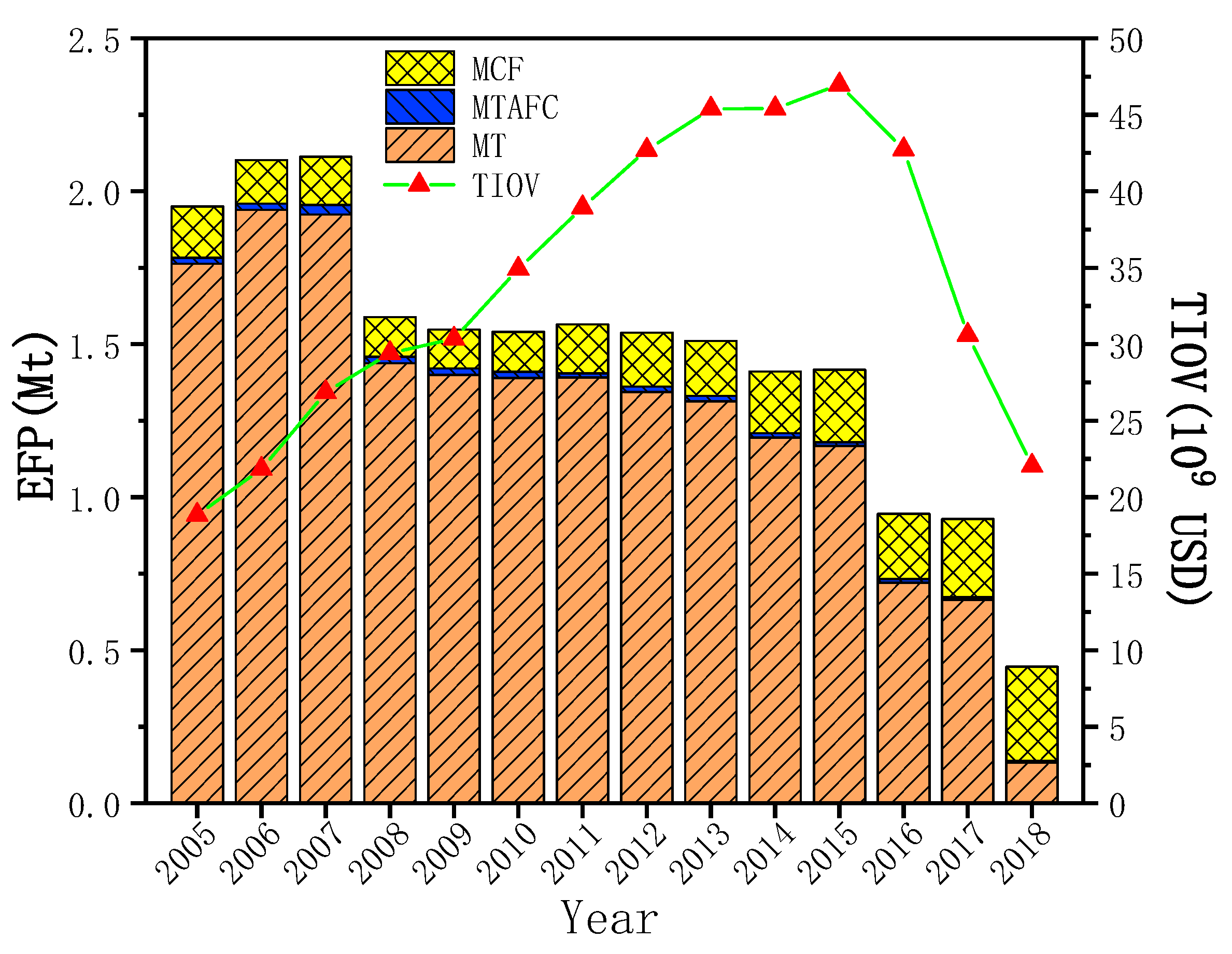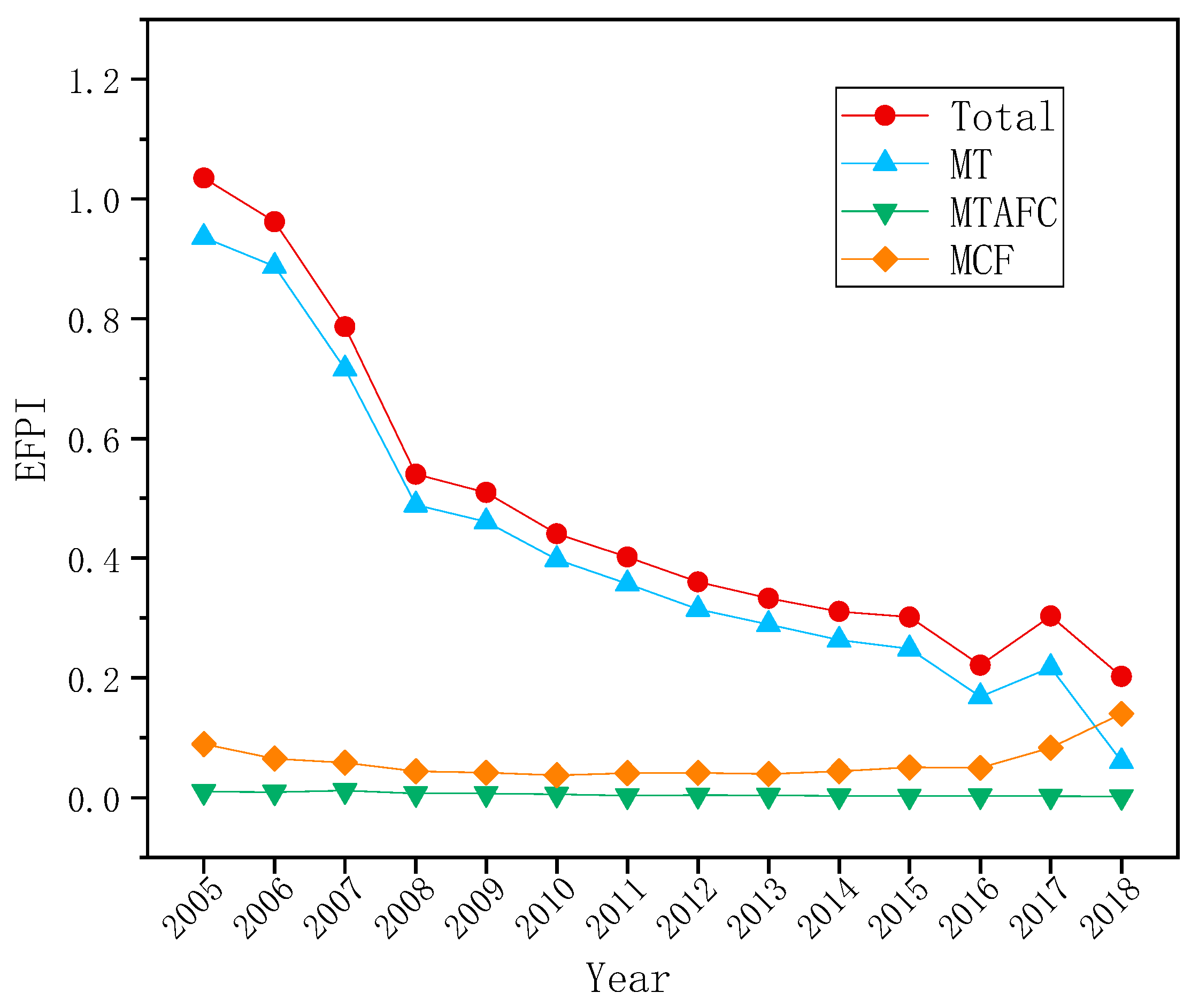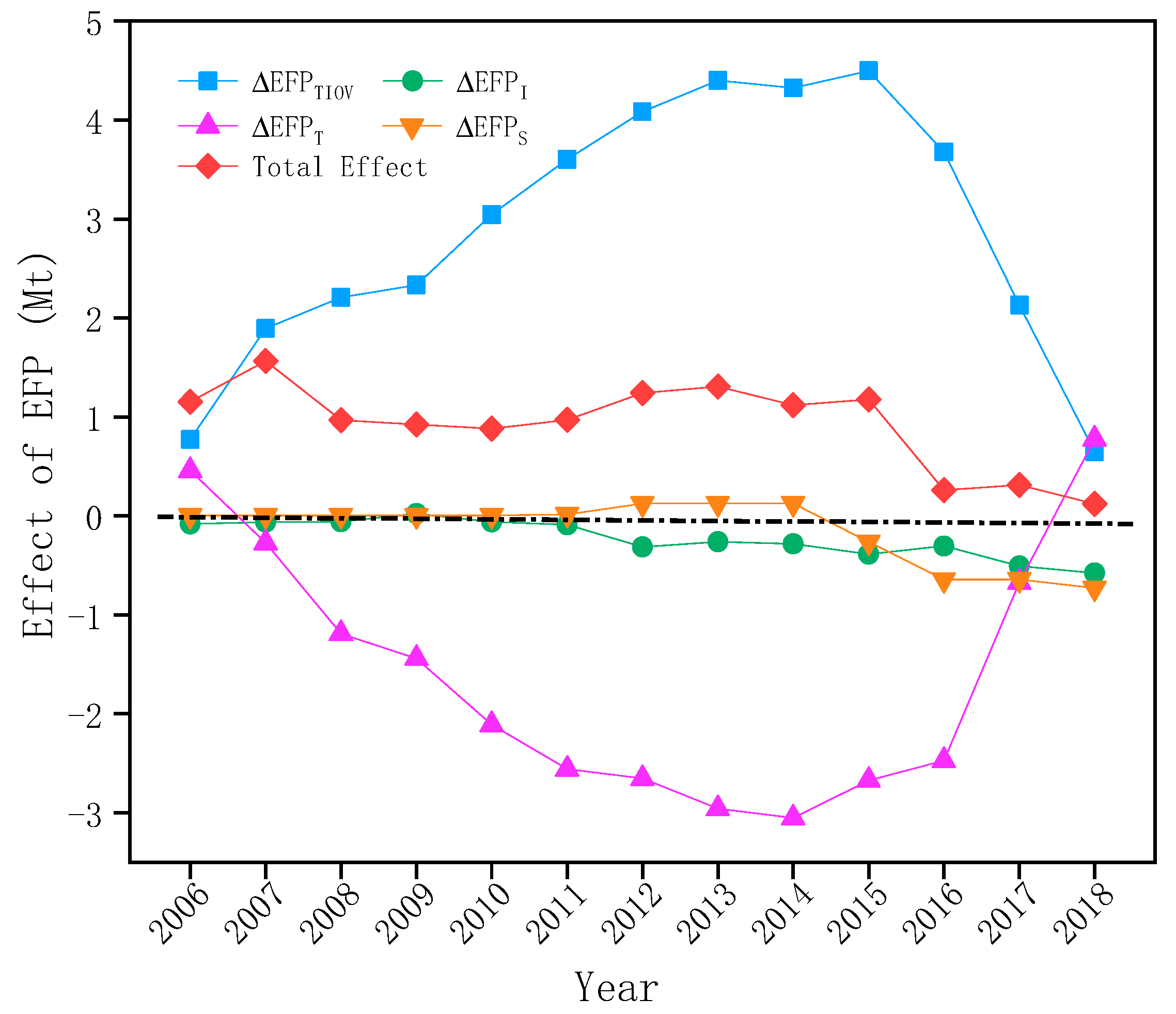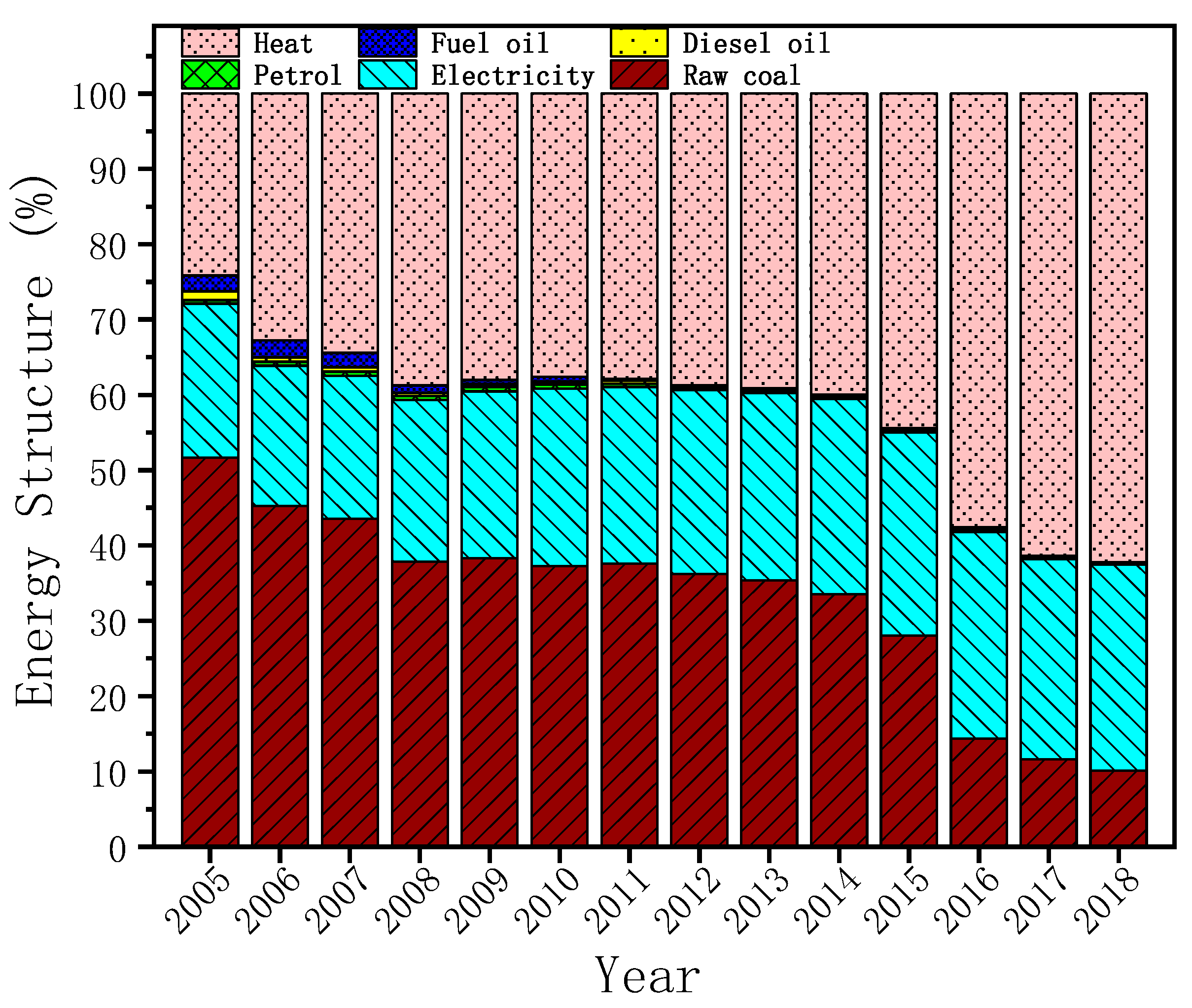Factorial Decomposition of the Energy Footprint of the Shaoxing Textile Industry
Abstract
1. Introduction
2. Methods and Data Sources
2.1. EFP
2.2. Tapio Decoupling Indicator
2.3. Logarithmic Mean Divisia Index (LMDI) Decomposition Model
2.4. Data Sources and Processing
3. Results and Discussion
3.1. Descriptive Analysis and Discussion
3.2. LMDI Decomposition Analysis and Discussion
4. Conclusions
Author Contributions
Funding
Acknowledgments
Conflicts of Interest
Appendix A
| Abbreviation | Detailed Name |
|---|---|
| EFP | Energy footprint |
| EFPI | Energy footprint intensity |
| TIOV | Total industrial output value |
| LMDI | Logarithmic mean Divisia index |
| MT | Manufacturer of textiles |
| MTAFC | Manufacturer of textile apparel, footwear and caps |
| MCF | Manufacturer of chemical fibers |
References
- Holdren, J.P. Science and Technology for Sustainable Well-being. Science 2008, 319, 424–434. [Google Scholar] [CrossRef]
- Magazzion, C. The Relationship among Economic Growth, CO2 Emissions and Energy Use in the APEC Countries: A Panel VAR Approach. Environ. Syst. Decis. 2017, 37, 353–366. [Google Scholar] [CrossRef]
- Li, Y.; Luo, Y.; Wang, Y.; Wang, L.; Shen, M. Decomposing the decoupling of water consumption and economic growth in China’s textile industry. Sustainability 2017, 9, 412. [Google Scholar] [CrossRef]
- Wang, Q.; Li, R.; Jiang, R. Decoupling and Decomposition Analysis of Carbon Emissions from Industry: A Case Study from China. Sustainability 2016, 8, 1059. [Google Scholar] [CrossRef]
- Shen, Y.; Lisa, A.A. Local environmental governance innovation in China: Staging ‘triangular dialogues’ for industrial air pollution control. J. Chin. Gov. 2018, 3, 351–369. [Google Scholar] [CrossRef]
- Guan, T.; Delman, J. Energy policy design and China’s local climate governance: Energy efficiency and renewable energy policies in Hangzhou. J. Chin. Gov. 2017, 2, 68–90. [Google Scholar] [CrossRef]
- Li, Y.; Ding, L.; Yang, Y. Can the Introduction of an Environment Target Assessment Policy Improve the TFP of Textile Enterprises? A Quasi-Natural Experiment Based on the Huai River in China. Sustainability 2020, 12, 1696. [Google Scholar] [CrossRef]
- Zhao, H.; Lin, B. Resources allocation and more efficient use of energy in China’s textile industry. Energy 2019, 185, 111–120. [Google Scholar] [CrossRef]
- Wang, L.; Li, Y.; He, W. The energy footprint of China’s textile industry: Perspectives from decoupling and decomposition analysis. Energies 2017, 10, 1461. [Google Scholar] [CrossRef]
- Li, Y.; Shen, J.; Lu, L.; Luo, Y.; Wang, L.; Shen, M. Water environment stress, rebound effect, and economic growth of China’s textile industry. PeerJ 2018, 6, e5112. [Google Scholar] [CrossRef]
- Zhao, H.; Lin, B. Impact of foreign trade on energy efficiency in China’s textile industry. J. Clean. Prod. 2020, 245, 118878. [Google Scholar] [CrossRef]
- Li, Y.; Wang, Y. Double decoupling effectiveness of water consumption and wastewater discharge in China’s textile industry based on water footprint theory. PeerJ 2019, 7, e6937. [Google Scholar] [CrossRef]
- China Statistics Press. China Statistical Yearbook on Science and Technology; China Statistics Press: Beijing, China, 1981–2013. (In Chinese) [Google Scholar]
- Notice of the Ministry of Industry and Information Technology on Distributing the Development Plan of the Textile Industry (2016–2020) MIIT Regulation [2016] No. 305. Available online: http://www.miit.gov.cn/n1146295/n1652858/n1652930/n3757019/c5267251/content.html (accessed on 28 February 2020). (In Chinese)
- Shaoxing Statistical Yearbook 2019. Available online: http://tjj.sx.gov.cn/art/2019/12/31/art_1489207_41684038.html (accessed on 13 February 2020). (In Chinese)
- Wackernage, M.; Lewan, L.; Hansson, C.B. Evaluating the use of natural capital with the ecological footprint Applications in Sweden and Subregions. AMBIO 1999, 28, 604–612. [Google Scholar]
- Palamutcu, S. Energy Footprints in the Textile Industry; Woodhead Publishing: Cambridge, UK, 2015; pp. 31–61. [Google Scholar]
- Lan, J.; Malik, A.; Lenzen, M.; McBain, D.; Kanemoto, K. A structural decomposition analysis of global energy footprints. Appl. Energy 2016, 163, 436–451. [Google Scholar] [CrossRef]
- Chen, S.Q.; Kharrazi, A.; Liang, S.; Fath, B.D.; Lenzen, M.; Yan, J.Y. Advanced approaches and applications of energy footprints toward the promotion of global sustainability. Appl. Energy 2020, 261, 114415. [Google Scholar] [CrossRef]
- Ozturk, H.K. Energy usage and cost in textile industry: A case study for Turkey. Energy 2005, 30, 2424–2446. [Google Scholar] [CrossRef]
- Hong, G.B.; Su, T.L.; Lee, J.D.; Hsu, T.C.; Chen, H.W. Energy conservation potential in Taiwanese textile industry. Energy Policy 2010, 38, 7048–7053. [Google Scholar] [CrossRef]
- Guo, S.; Zheng, S.; Hu, Y.; Hong, J.; Wu, X.; Tang, M. Embodied energy use in the global construction industry. Appl. Energy 2019, 256, 113838. [Google Scholar] [CrossRef]
- Chen, G.Q.; Wu, X.F. Energy overview for globalized world economy: Source, supply chain and sink. Renew. Sustain. Energy Rev. 2017, 69, 735–749. [Google Scholar] [CrossRef]
- Chen, Z.M.; Chen, G.Q. An overview of energy consumption of the globalized world economy. Energy Policy 2011, 39, 5920–5928. [Google Scholar] [CrossRef]
- Chen, B.; Chen, G.Q.; Yang, Z.F.; Jiang, M.M. Ecological footprint accounting for energy and resource in China. Energy Policy 2007, 35, 1599–1609. [Google Scholar] [CrossRef]
- Zhang, B.; Qiao, H.; Chen, Z.M.; Chen, B. Growth in embodied energy transfers via China’s domestic trade: Evidence from multi-regional input-output analysis. Appl. Energy 2016, 184, 1093–1105. [Google Scholar] [CrossRef]
- Zhang, B.; Chen, Z.M.; Xia, X.H.; Xu, X.Y.; Chen, Y.B. The impact of domestic trade on China’s regional energy uses: A multi-regional input-output modeling. Energy Policy 2013, 63, 1169–1181. [Google Scholar] [CrossRef]
- Wilson, J.; Tyedmers, P.; Grant, J. Measuring environmental impact at the neighbourhood level. J. Environ. Plan. Manag. 2013, 56, 42–60. [Google Scholar] [CrossRef]
- Bordigoni, M.; Hita, A.; Blanc, G.L. Role of embodied energy in the European manufacturing industry: Application to short-term impacts of a carbon tax. Energy Policy 2012, 43, 335–350. [Google Scholar] [CrossRef]
- Crawford, R.H. Validation of the use of input-output data for embodied energy analysis of the australian construction industry. J. Constr. Res. 2005, 6, 71–90. [Google Scholar] [CrossRef]
- Zhao, Y.; Onat, N.C.; Kucukvar, M.; Tatari, O. Carbon and energy footprints of electric delivery trucks: A hybrid multi-regional input-output life cycle assessment. Transp. Res. Transp. Environ. 2016, 47, 195–207. [Google Scholar] [CrossRef]
- Lenzen, M.; Dey, C. Truncation error in embodied energy analyses of basic iron and steel products. Energy 2000, 25, 577–585. [Google Scholar] [CrossRef]
- Wiedmann, T. A first empirical comparison of energy Footprints embodied in trade-MRIO versus PLUM. Ecol. Econ. 2009, 68, 1975–1990. [Google Scholar] [CrossRef]
- Wang, H.; Wang, G.; Qi, J.; Schandl, H.; Li, Y.; Feng, C.; Liang, S. Scarcity-weighted fossil fuel footprint of China at the provincial level. Appl. Energy 2020, 258, 114081. [Google Scholar] [CrossRef]
- Chang, Y.; Ries, R.J.; Wang, Y. The embodied energy and environmental emissions of construction projects in China: An economic input-output LCA model. Energy Policy 2010, 38, 6597–6603. [Google Scholar] [CrossRef]
- Cucek, L.; Klemes, J.J.; Kravanja, Z. A review of footprint analysis tools for monitoring impacts on sustainability. J. Clean. Prod. 2012, 34, 9–20. [Google Scholar] [CrossRef]
- Kenourgios, D.; Drakonaki, E.; Dimitriou, D. ECB’s unconventional monetary policy and cross-financial-market correlation dynamics. N. Am. J. Econ. Financ. 2019, 50, 101045. [Google Scholar] [CrossRef]
- Tapio, P. Towards a theory of decoupling: Degrees of decoupling in the EU and the case of road traffic in Finland between 1970 and 2001. Transp. Policy 2005, 12, 137–151. [Google Scholar] [CrossRef]
- Hao, Y.; Huang, Z.; Wu, H. Do Carbon Emissions and Economic Growth Decouple in China? An Empirical Analysis Based on Provincial Panel Data. Energies 2019, 12, 2411. [Google Scholar] [CrossRef]
- Zhang, Y.; Zou, X.; Xu, C.; Yang, Q. Decoupling Greenhouse Gas Emissions from Crop Production: A Case Study in the Heilongjiang Land Reclamation Area, China. Energies 2018, 11, 1480. [Google Scholar] [CrossRef]
- Roman, R.; Cansino, J.M.; Botia, C. How far is Colombia from Decoupling? Two-level decomposition analysis of energy consumption changes. Energy 2018, 148, 687–700. [Google Scholar] [CrossRef]
- Li, Y.; Lu, L.; Tan, Y.; Wang, L.; Shen, M. Decoupling water consumption and environmental impact on textile industry by using water footprint method: A case study in China. Water 2017, 9, 124. [Google Scholar] [CrossRef]
- Ang, B.W. The LMDI approach to decomposition analysis: A practical guide. Energy Policy 2005, 33, 867–871. [Google Scholar] [CrossRef]
- Xia, C.; Li, Y.; Ye, Y.; Shi, Z.; Liu, J. Decomposed driving factors of carbon emissions and scenario analyses of low-carbon transformation in 2020 and 2030 for Zhejiang Province. Energies 2017, 10, 1747. [Google Scholar] [CrossRef]
- The People’s Government of Zhejiang Province during the ‘12th Five-Year Plan’ Period of Heavy Pollution and High Energy Consumption, the Guiding Opinions on Deepening the Rectification of the Industry and Promoting Improvement (Zhe Zheng Fa [2011] No. 107). Available online: http://www.zj.gov.cn/art/2012/7/14/art_1582424_26042073.html (accessed on 13 February 2020). (In Chinese)
- Implementation Plan for the Transformation and Upgrade of the Printing and Dyeing Industry in Shaoxing City (Shao Zheng Ban Fa [2013] No. 106). Available online: http://www.sx.gov.cn/art/2013/7/16/art_1467567_160160.html (accessed on 13 February 2020). (In Chinese)
- Notice of the Shaoxing Municipal People’s Government Office on Accelerating the Coal-to-Natural Gas Work of Printing and Dyeing Enterprises (Shao Zheng Ban Fa (2012) No. 158). Available online: http://www.sx.gov.cn/art/2013/2/19/art_1463812_18069826.html (accessed on 13 February 2020). (In Chinese)
- Liu, Z.; Guan, D.; Douglas, C.B.; Zhang, Q.; He, K.; Liu, J. A low-carbon road map for China. Nature 2013, 500, 143–145. [Google Scholar] [CrossRef] [PubMed]
- Qin, Y.; Höglund-Isaksson, L.; Byers, E.; Feng, K.; Wagner, F.; Peng, W.; Mauzerall, D.L. Air quality–carbon–water synergies and trade-offs in China’s natural gas industry. Nat. Sustain. 2018, 1, 505–511. [Google Scholar] [CrossRef]




| Decoupling State | |||
|---|---|---|---|
| Strong decoupling | − | + | (−∞, 0) |
| Weak decoupling | + | + | (0, 0.8) |
| Recessive decoupling | − | − | (1.2, +∞) |
| Expansive coupling | + | + | (0.8, 1.2) |
| Recessive coupling | − | − | (0.8, 1.2) |
| Expansive negative decoupling | + | + | (1.2, +∞) |
| Weak negative decoupling | − | − | (0, 0.8) |
| Strong negative decoupling | + | − | (−∞, 0) |
| Variable | Meaning | Variable | Meaning |
|---|---|---|---|
| the consumption amount of energy j in the subsector i | TIOV proportion of subsector i in textile industry, i.e., the industry structure factor | ||
| the TIOV of subsector i | The energy intensity of subsector i | ||
| the total energy consumption in the subsector i | The ratio of energy j consumption in subsector i to total energy consumption in the industry, i.e., the energy structure factor |
| Year | Decoupling State | |||
|---|---|---|---|---|
| 2006 | 0.08 | 0.17 | 0.45 | Weak decoupling |
| 2007 | 0.01 | 0.26 | 0.02 | Weak decoupling |
| 2008 | −0.25 | 0.16 | −1.55 | Strong decoupling |
| 2009 | −0.03 | 0.03 | −0.95 | Strong decoupling |
| 2010 | −0.01 | 0.20 | −0.03 | Strong decoupling |
| 2011 | 0.02 | 0.17 | 0.09 | Weak decoupling |
| 2012 | −0.02 | 0.12 | −0.15 | Strong decoupling |
| 2013 | −0.02 | 0.08 | −0.23 | Strong decoupling |
| 2014 | −0.07 | 0.02 | −3.55 | Strong decoupling |
| 2015 | 0.005 | 0.04 | 0.12 | Strong decoupling |
| 2016 | −0.33 | −0.08 | 4.39 | Recessive decoupling |
| 2017 | −0.02 | −0.27 | 0.07 | Weak negative decoupling |
| 2018 | −0.04 | −0.26 | 0.14 | Weak negative decoupling |
© 2020 by the authors. Licensee MDPI, Basel, Switzerland. This article is an open access article distributed under the terms and conditions of the Creative Commons Attribution (CC BY) license (http://creativecommons.org/licenses/by/4.0/).
Share and Cite
Wang, X.; Chen, X.; Cheng, Y.; Zhou, L.; Li, Y.; Yang, Y. Factorial Decomposition of the Energy Footprint of the Shaoxing Textile Industry. Energies 2020, 13, 1683. https://doi.org/10.3390/en13071683
Wang X, Chen X, Cheng Y, Zhou L, Li Y, Yang Y. Factorial Decomposition of the Energy Footprint of the Shaoxing Textile Industry. Energies. 2020; 13(7):1683. https://doi.org/10.3390/en13071683
Chicago/Turabian StyleWang, Xiaopeng, Xiang Chen, Yiman Cheng, Luyao Zhou, Yi Li, and Yongliang Yang. 2020. "Factorial Decomposition of the Energy Footprint of the Shaoxing Textile Industry" Energies 13, no. 7: 1683. https://doi.org/10.3390/en13071683
APA StyleWang, X., Chen, X., Cheng, Y., Zhou, L., Li, Y., & Yang, Y. (2020). Factorial Decomposition of the Energy Footprint of the Shaoxing Textile Industry. Energies, 13(7), 1683. https://doi.org/10.3390/en13071683





